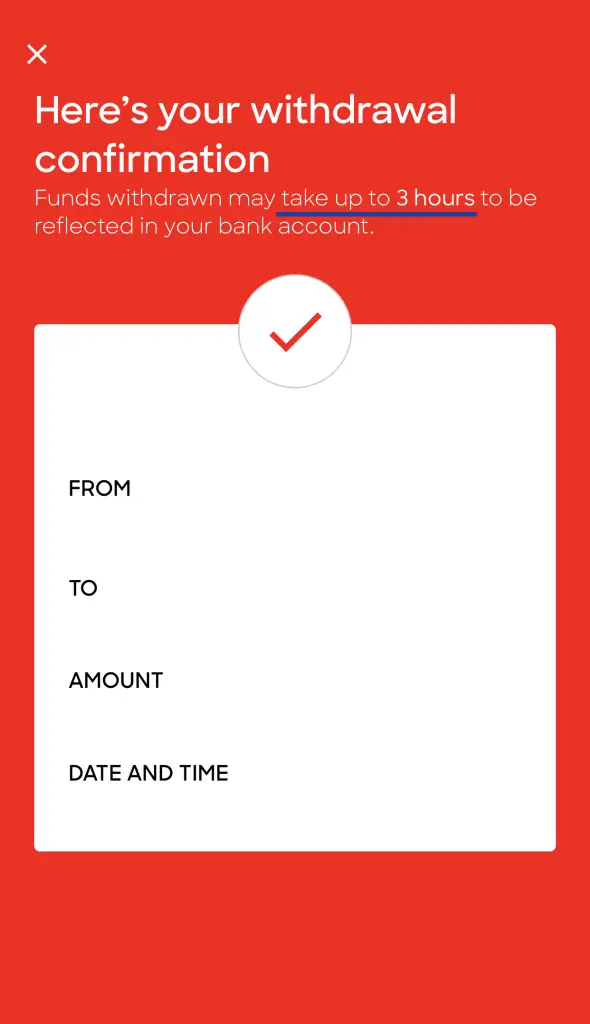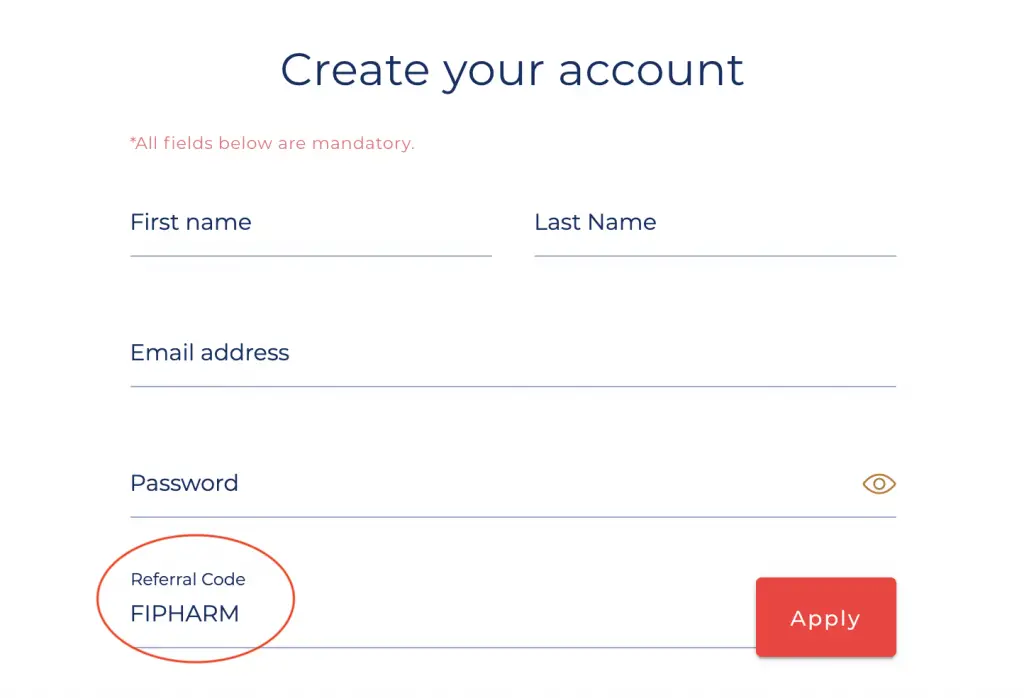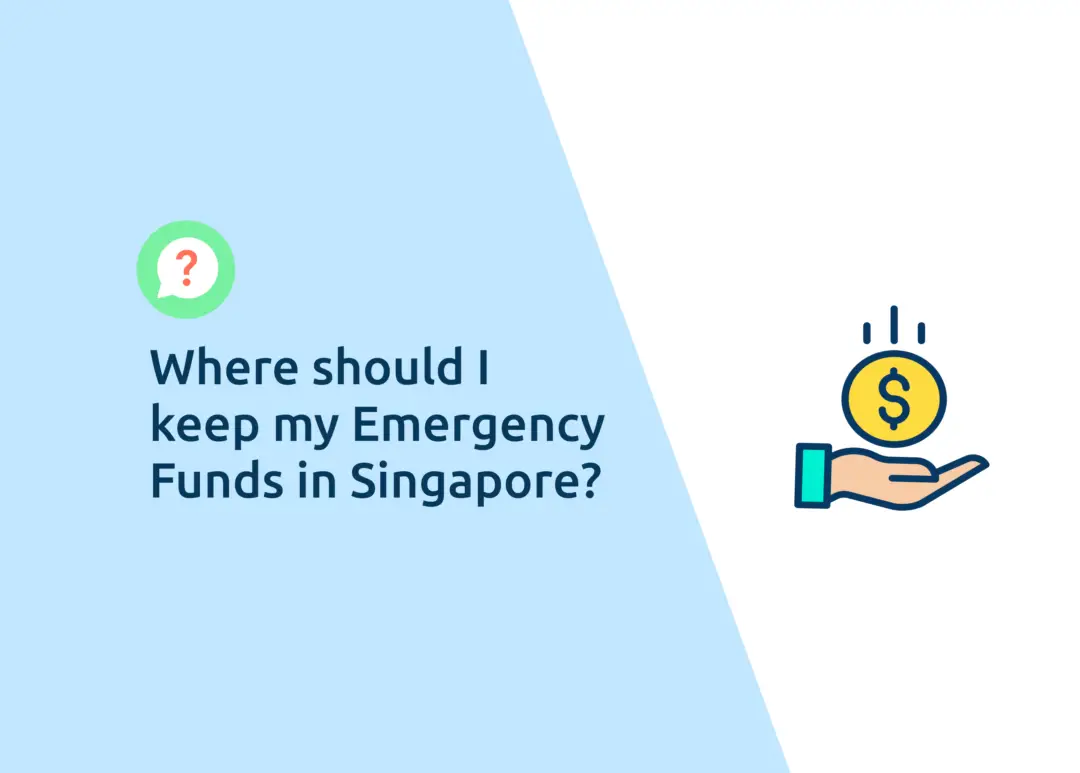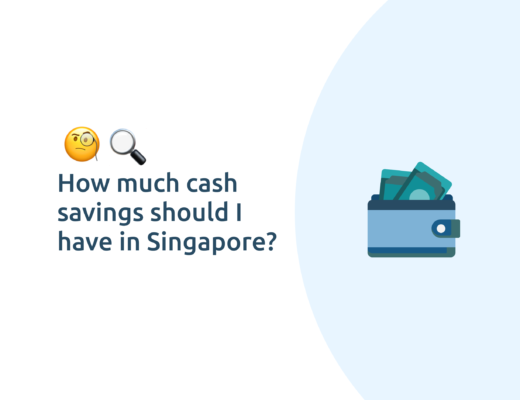Last updated on September 21st, 2021
You know that an emergency fund is important before you start investing. While you want your emergency fund to be liquid, you do not want it to lose its value!
This is because most savings accounts offer really low interest rates.
So where should you be placing your emergency funds in?
Contents
Where should I put my emergency funds in Singapore?
Here are 6 places you can consider placing your emergency funds in:
- Cash
- Savings Accounts
- Insurance Savings Plans
- Cash Management Accounts
- Fixed Deposits
- Singapore Savings Bonds (SSBs)
This is a summary of each instrument,
| Instrument | Pros | Cons |
|---|---|---|
| Cash | The most liquid option | Fastest way to lose value due to inflation |
| Savings Account | Very liquid option | Poor rate of returns |
| Insurance Savings Plans | Higher returns compared to savings accounts | May incur transaction fees for withdrawals Relatively less liquid option |
| Cash Management Account | Higher returns compared to savings accounts | May be less liquid compared to Insurance Savings Plans |
| Fixed Deposits | Slightly higher returns compared to savings accounts | Lock-up period of at least 3 months You may incur penalties for withdrawing early |
| Singapore Savings Bonds (SSBs) | Slightly higher returns compared to savings accounts | Redemption requests need to be made 1 month in advance $2 transaction fee per redemption |
and here is an in-depth explanation of each instrument:
Cash
Stashing your emergency fund as cash seems pretty ideal.
When you need the money, you can access it immediately. Sounds good, right?
Many people like to hide their cash at home.
However, here are some downsides to leaving your money in cash:
You may be tempted to spend it
Knowing that you have a huge stash of cash at home may not be good for your self-control.
While building up your emergency fund, you should decide on the situations that you can draw money from this fund.
If you don’t set the criteria at the start, you might find excuses to use these funds. Eventually, you may start to use these funds for other situations instead of emergencies!
Your money will erode over time
Inflation is a cash killer. As the prices of goods increase over time, your emergency fund’s purchasing power decreases.
The amount that you’ve saved may be worth much less 10 years later.
To protect your emergency fund from inflation, it would be best not to leave it in cash. Rather, you can consider other options that will give you some returns.
Verdict
There are many downsides to leaving your emergency funds in cash. It may still be worth keeping some of your emergency savings in cash due to its high liquidity.
Nevertheless, this is the fastest way that your cash will erode in value due to inflation!
Savings Accounts
Bank accounts are great because they:
- Are very liquid
- Are a safe place to store your money
- Are insured by SDIC if the bank closes down (but only up to $75k per bank)
However, most accounts do not give attractive interest rates.
The base rate for most accounts is 0.05%.
Therefore, choosing the right bank account for your emergency fund is key. I have come up with 2 criteria when it comes to a suitable bank account for emergency funds:
- Reasonable interest rate without needing to meet any requirements
- No or low average monthly balance (at most $500)
I do not want to have a minimum balance in my emergency savings account as I may need to withdraw all of the money for the emergency.
Here are 5 bank accounts that you can consider to store your emergency fund:
- Standard Chartered JumpStart Account
- CIMB FastSaver Account
- DBS My Account
- RHB High Yield Savings Account
- POSB eMySavings Account
Standard Chartered JumpStart Account
If you are between 18-26 years old, you should seriously consider signing up for this account.
Here’s the interest rate that you’ll receive:
| Amount | Interest Rate |
|---|---|
| First $20k | 0.4% |
| ≥ $20k | 0.1% |
The best part is that it does not have any minimum balance you are required to maintain.
I personally use it as my spending account as it offers me 1% cashback on any Mastercard spending.
CIMB FastSaver Account
CIMB FastSaver is another account that does not have a minimum balance. However, you are required to have at least $1k in the account to continue earning interest.
Here are the interest rates for this account, depending on the amount that you have:
| Amount | Interest Rate |
|---|---|
| First $75k | 0.3% |
| > $75k | 0.15% |
The interest rate is slightly lower than JumpStart, but it is still not too bad.
DBS My Account
The DBS My Account is very similar to the Multiplier Account.
However, you are not able to earn the bonus interest if you make eligible transactions, such as:
- Salary Credit
- Home Loan Financing
- Credit Card Spend
- Insurance
- Investment
The main advantage of the DBS My Account is that it does not have a minimum balance. Meanwhile, the DBS Multiplier has a minimum sum of $3k (if you are ≥ 29 years old).
The only con about the My Account is that you’ll only receive 0.05% in interest.
I currently have a Multiplier Account, and I am considering switching to My Account when I reach 29 years old.
This is mainly due to the ‘no minimum sum requirement’, as I want to keep as little cash in savings as possible.
RHB High Yield Savings Account
The RHB High Yield Savings Account is similar to the CIMB FastSaver, where you able to earn around 0.3% to 0.5%.
| Amount | Interest Rate |
|---|---|
| First $50k | 0.30% |
| Next $25k | 0.40% |
| Next $25k | 0.50% |
| > $100k | 0.20% |
While CIMB FastSaver offers you a lower interest rate if you have > $75k, RHB gives you a slightly better interest rate if you have more money with them.
The RHB High Yield Savings Account does not have a fall-below fee. However, you will need to have at least $1k in the account for you to earn the interest.
POSB DBS eMySavings Account
The POSB DBS eMySavings Account does not have a minimum amount you are required to have in the account.
However, you are required to make a certain amount of monthly contribution to earn a higher interest rate.
Here are the interest rates based on the monthly contribution you make:
| Monthly Contribution | Interest Rate |
|---|---|
| $50 – $290 | 0.05% |
| $300 – $790 | 0.2% |
| $800 – $1,490 | 0.25% |
| $1,500 – $3,000 | 0.25% |
| Other scenarios | 0.05% |
Here are some scenarios which will result in you only earning 0.05% in interest:
- Failed crediting of monthly contribution
- Withdrawal from the bank account
- Account closure during the month
If you make a withdrawal from the account, you will forfeit the bonus interest you are eligible for!
I believe that this account is good if you want to build up a saving habit through the extra interest incentive. Apart from that, you may want to consider other accounts instead.
Verdict
Savings accounts are a good place to store some of your emergency funds due to the liquidity it provides. You are able to access the funds if you need them immediately.
However with high liquidity, you will also receive lower returns. This is the trade-off you’ll make.
As such, I believe you should not place all of your funds in a savings account. This is because your funds will lose value due to inflation!
Instead, you can consider putting only a portion of your funds into a savings account. The rest of the funds can be placed in instruments that give you a higher yield.
Insurance Savings Plans
Insurance savings plans have become rather flexible. They are plans offered by insurance companies that:
- Give you insurance coverage for Life and Total and Permanent Disability (TPD)
- Provide you with a decent rate of return
You are able to receive some insurance coverage, and may earn a higher return compared to savings accounts!
However, the returns are still much lower compared to those investing in other instruments.
I believe that you should use insurance savings funds for these 2 financial goals:
- Emergency funds
- Savings for short term goals
Another thing you’ll need to take note of are the terms and conditions of these plans. Particularly, you’ll need to look at:
- The transaction fees when you make a withdrawal
- The number of days it takes for your funds to be transferred to your bank account
There are a variety of insurance savings plans, such as:
- SingLife Account
- Etiqa ELASTIQ
- Dash EasyEarn
- Etiqa GIGANTIQ
- Dash PET
Verdict
Insurance savings plans may provide a higher return on your emergency funds compared to savings accounts.
However, they are considered to be less liquid than a savings account too.
As such, you should still put some of your funds in a savings account!
Cash Management Accounts
Cash management accounts aim to provide you a higher rate of return compared to a savings account.
They do this by investing your funds into different instruments, such as:
- Fixed deposits with banks
- Short-term government and corporate bonds
- Money market funds
Most of these instruments have a lower liquidity compared to a savings account. However, they are able to provide you with a slightly higher rate of return.
Here are some examples of cash management accounts that are being offered:
| Account | Projected Yield | Withdrawal Time |
|---|---|---|
| Endowus Cash Smart | Core: ~ 0.8% – 1% Enhanced: ~ 1.2% – 1.5% Ultra: ~1.8% – 2% | 6 (Cash) and 10 (SRS) business days |
| Syfe Cash+ | ~ 1.5% | 4-5 business days |
| StashAway Simple | ~ 1.2% | 3-4 business days |
| MoneyOwl WiseSaver | ~ 0.43% | 1-2 business days |
| FSMOne Auto-Sweep | ~ 0.6% | T+3 business days |
Most of these accounts invest in rather similar funds. While some of them have a higher projected yield, it may take a longer time for you to receive your funds after withdrawing them.
Although the returns seem better, you may want to take note that cash management accounts are not capital guaranteed.
The returns you receive depend on the performance of the underlying funds that the cash management account invests in.
As such, you’ll need to carefully consider this fine balance between returns and liquidity!
Verdict
Cash management accounts may provide you with higher returns, but at the cost of liquidity.
The returns you earn may be able to keep pace with inflation, so this ensures that your funds do not erode in value too much.
I would suggest putting some of your emergency funds into these accounts, but not all of it!
Fixed Deposits
Fixed deposits are usually offered by banks. They are ‘special bank accounts’ where you leave your money inside for a fixed period of time.
You will usually get a higher interest rate compared to leaving your cash in a normal bank account.
However, there are 2 things you’ll need to take note of:
- All fixed deposits have a lock-up period
- You will incur a penalty if you withdraw before the end of the lock-up period
If you choose to withdraw your fixed deposits earlier, you will incur a penalty (depending on the bank).
This may include:
- Lower or no interest accrued on your funds
- Early withdrawal fees
Verdict
Due to the lock-up period and penalties for withdrawal, a fixed deposit may not be the best place to keep your emergency funds.
Singapore Savings Bonds
Singapore Savings Bonds (SSBs) are another instrument you can consider leaving your emergency funds in.
SSBs are bonds being offered by the Singapore Government, and you are able to earn interest by lending your money to the government
SSBs have a ‘step-up interest‘. This means that the longer that you hold your funds in the bond, you will be able to receive higher interest rates.
You can invest a minimum of $500 for each SSB, and subsequent multiples of $500. The interest will be paid out to you every 6 months.
However, things can get a bit tricky when you want to withdraw your funds.
You will need to make a redemption request one month in advance. After submitting your request, the funds along with the accrued interest will be transferred by the 2nd business day of the following month.
Furthermore, you will need to pay a $2 transaction fee for each redemption!
Verdict
When you are deciding to place your emergency funds into a SSB, you will need to consider the returns that you will receive.
While the ‘step-up’ interest may look really high, that is usually only for the last few years. If you withdraw your funds too early, you may receive rather low returns!
One way to help with your decision is to compare the returns of the SSB with the other options with slightly higher liquidity.
You may want to consider choosing SSBs over other instruments if they provide a higher effective interest rate compared to the other instruments.
However, you’ll need to consider the one-month withdrawal time as well!
Due to the hassle you’ll face with withdrawing your funds, SSBs may not be the best place to store your emergency fund.
You can consider using a tiered emergency fund
A tiered emergency fund is where you place your emergency funds into different instruments, each having different liquidity and returns. This ensures that you can strike a balance to ensure your funds are liquid, yet being able to generate some returns to keep pace with inflation.
I’m using 3 different instruments to store my emergency fund:
| Account | Rate of Return |
|---|---|
| Standard Chartered JumpStart | 0.4% for first $20k |
| SingLife Account | 1.5% for first $10k |
| Syfe Cash+ | ~ 1.5% (no limit) |
While JumpStart is the most liquid option, I am only receiving a 0.4% yield.
I am placing around 10% of my emergency fund inside, which will help me to pay for any immediate emergencies.
For the rest of my funds, I want them to earn a higher return, so that it does not lose value in the long term.
This is why I have chosen to place them in places that earn a slightly higher yield, with relatively lower liquidity.
For example, the SingLife Account will transfer your funds in around 3 hours.

Meanwhile, Syfe Cash+ takes around 2-3 business days to credit your funds in your bank account.
These options are still relatively liquid. In the event that I have an emergency that is greater than the amount in JumpStart, I can still choose to withdraw from the SingLife Account.
You can consider mixing and matching different products for your emergency fund
Your emergency fund is a huge sum of money, and I believe that you should not place it all in just one place.
The biggest emergency that you’ll face is losing your job. Even then, you would not need your entire emergency fund immediately!
As such, you can consider using multiple accounts, each providing different levels of returns and liquidity.
In this case, you are able to draw upon the most liquid option first for immediate emergencies. After that, you can withdraw from the less liquid options if you still need more cash.
You should still leave around 10% of your emergency fund in a savings account, to have some liquidity for immediate emergencies!
Conclusion
There are many places that you can consider storing your emergency funds in. You can consider these products when you are placing your savings for your student loan repayments too.
However, you should not leave all of your funds either in cash or in a savings account. Due to the low returns, your cash will definitely erode in value!
There is always the balance between liquidity and returns for each of these instruments. You can consider using a tiered emergency fund to ensure that some of your funds are still keeping pace with inflation!
👉🏻 Referral Deals
If you are interested in signing up for any of the products mentioned above, you can check them out below!
Endowus Referral (Receive a $20 Access Fee Credit)
If you are interested in signing up for Endowus, you can use my referral link to create your account.
You will receive a $20 access fee credit, irregardless of the amount that you start investing with Endowus.
The access fee does not have any expiry date. As such, you can invest at any pace that you wish, and still get $20 off your fees!
SingLife Account and Grow Referral (Up to $35 credited)
If you are interested in signing up for a SingLife Account or buying a SingLife Grow plan, you can use my referral link or the referral code: ‘K8KXV6cv‘.
Here’s what you need to do:
- Sign up for a SingLife Account with my referral link or use the code ‘K8KXV6cv’
- Order and activate your SingLife Visa Debit Card (Earn $5)
- Sign up for a SingLife Grow policy with the code ‘K8KXV6cv’
- Fund your policy with a minimum of $1,000 (Earn $30)
You can read more about this referral program on SingLife’s website.
Syfe Referral (Up to $30,000 SGD managed for free for 3 months)
If you are interested in signing up for Syfe, you can use the referral code ‘FIPHARM‘ when you are creating your account. You will have your first $30,000 invested with Syfe managed for free for your first 3 months.
You will be able to save up to $75 worth of fees!
This applies only to the money that you’ve invested in Syfe’s 3 portfolios. If you are using only Syfe Cash+, you will not be charged any fees by Syfe!

You can view more information about this referral program on Syfe’s website.
StashAway Referral (Up to $40,000 SGD managed for free for 6 months)
If you are interested in signing up for StashAway, you can use my referral link to sign up.
Here’s what you’ll need to do:
- Sign up for a StashAway account
- Make a deposit of ≥ $10k within 4 weeks of signing up
- Receive a fee waiver for 6 months (up to $40k)
You can find out more about this program on SingSaver.
Dash Referral (Receive 800 Welcome Bonus Points)
If you are interested in signing up for Singtel Dash, you can use my referral link to sign up.
Alternatively, you can use my referral code ‘DASH-R1W67‘.
You will be able to receive 800 welcome bonus points once you either make a:
- Dash payment or
- Singtel prepaid top-up (minimum $10)

Do you like the content on this blog?
To receive the latest updates from my blog and personal finance in general, you can follow me on my Telegram channels (Personal Finance or Crypto) and Facebook.
Are you passionate about personal finance and want to earn some flexible income?






